Baby Ear Piercing: Right Age, Infection, Healing & Aftercare
Take all the proper steps to ensure your little one’s piercings heal quickly.
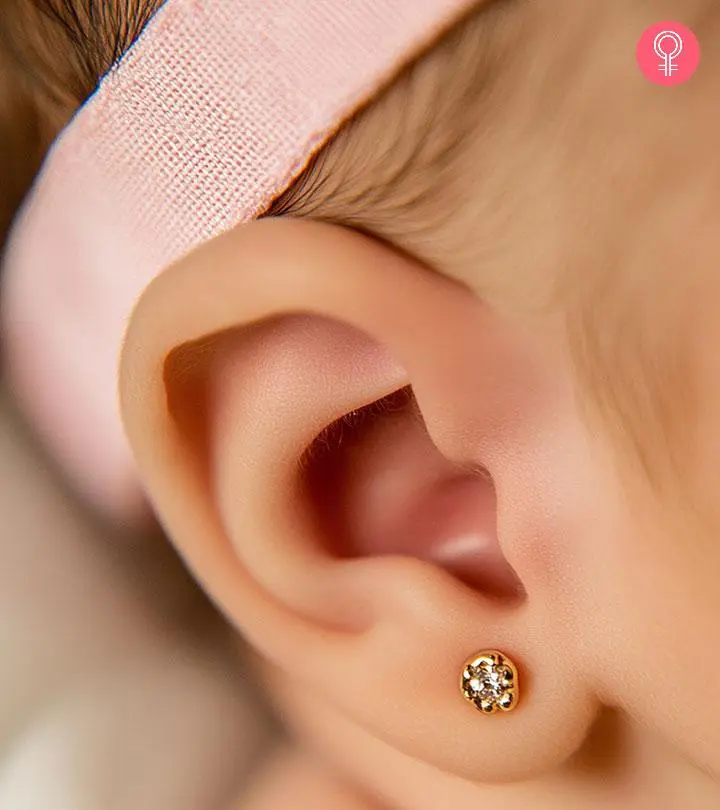
Image: Midjourney/ StyleCraze Design Team
Ear piercings are one of the most common and oldest forms of body modification. For many parents, piercing their baby’s ears marks a special milestone. However, opinions about this practice vary, with some people concerned about violating the baby’s autonomy. In some countries and cultures, ear piercings are a rite of passage. In places like Spain, Latin America, India, Africa, and the Middle East, it is common to pierce a baby’s ears shortly after birth, sometimes even before leaving the hospital. However, the American Academy of Pediatrics recommends waiting until the child is older and can take care of the piercings to reduce the chances of infection. Read on to learn all about ear piercings for babies, so you can make an informed decision.
 Piercing Guide: Baby Ear Piercing
Piercing Guide: Baby Ear Piercing- Placement: Earlobes
- Best Jewelry: Small stud earring with rounded edges and flat backs
- Cost: $30 to $100
- Pain Level: Low
- Healing Time: 6 weeks
 Trivia
TriviaIn This Article
Cultural Perspectives On Baby Ear Piercing
Ear piercing has been a cultural practice for centuries. It has different significance across various regions.
The Karnvedh Sanskar is a significant ceremony in many Hindu traditions, marking the auspicious piercing of a child’s ears. It is a ritual performed for both boys and girls. For girls, the left ear is pierced first followed by the right, while for a boy, the right ear is pierced first and then the left. This tradition continues in many Hindu families today.
In Mexico and other Latin American countries, ear piercing services are even offered in hospitals for newborns. The tradition is closely tied to femininity and cultural identity.
Other cultures have different perspectives on ear piercing. In some Western countries, it is more common for children to have their ears pierced later in their childhood or adolescence. This allows them to decide if they want to pierce their ears or not. In some cultures, ear piercing is not a common practice at all.
It is important to note that cultural practices and beliefs vary widely. There is no one-size-fits-all approach to ear piercing. Parents should consider their own cultural background, personal preferences, and their child’s comfort level when making decisions about ear piercing. Learn more about the timing in the next section.
Key Takeaways
- Baby ear piercing may be done for cultural reasons or the personal preference of the parents.
- It is not without risks and can cause infection, allergic reaction, scarring, or trauma.
- It is best to get your baby’s ears pierced in a hospital under the observation of the pediatrician or a qualified piercer.
- Proper aftercare is crucial to relieve pain and enable quick healing. Use the right jewelry, apply antibiotics, rotate twice daily, and keep the area clean and dry for optimal results.
When Should You Pierce A Baby’s Ears?

Deciding when to pierce the child’s ears is largely dependent on the parents. Some like to get it pierced during infancy as the baby is less active, so it is easier to manage the child during the piercing process. Others prefer that the child become old enough to make their decision regarding the piercing. Nevertheless, when considering getting a piercing, several factors should be taken into account, as listed below:
- One of the earliest significant piercing concerns is off-center piercings as the child grows. But you need not worry about it, as the growth of the ear lobe with increasing age does not affect the ear piercing.
- When babies are small, they are easier to handle during the piercing process, since they do not move around much.
- It is also wise to wait two months and get the piercing after the DTaP (diphtheria, tetanus, and acellular pertussis) vaccine. The tetanus injection protects from infection due to puncture wounds and foreign objects.
- At three months of age, the baby has a more robust immune system, so some pediatricians suggest that this is the optimal time for ear piercing. Even if there were an infection at the piercing site, the immune response system can act against the infection without needing hospital admission.
- You can also wait till the baby is four months old and has completed two sets of tetanus vaccinations.
- The risk of infection is higher with older kids as they tend to touch the ears more often than newborns.
- Keloids at the piercing site are more common among children above 11 than those below (1).
 Trivia
TriviaAs you have explored the various aspects to determine when to pierce your baby’s ears, it is also essential to weigh the pros and cons of the methods employed in the process. Let us understand which is better, a piercing gun or needle.
Is It Better To Pierce A Baby’s Ears With A Needle Or A Gun?
Piercing guns are readily available and accessible, but they cannot be sterilized thoroughly as compared to needles. The use of contaminated piercing guns can quickly cause an infection that can, in the worst cases, develop into hepatitis. Guns can cause tissue damage and prolong healing due to blunt force trauma. Furthermore, baby ear lobes are small, hence piercing at the right spot with a marking is essential. A precise piercing angle can be attained with a needle rather than a gun.
In medical piercing, the needles are autoclaved, and the process is done with strict adherence to sterility, which reduces the healing time, causes less tissue trauma, and is more hygienic compared to a piercing gun.
After you have chosen the process of piercing, where you get your baby’s ear pierced also determines the safety of the process to ensure a comfortable experience for your little one. Check below for some options where you can get your baby’s ears pierced.
Where Should You Pierce A Baby’s Ears?
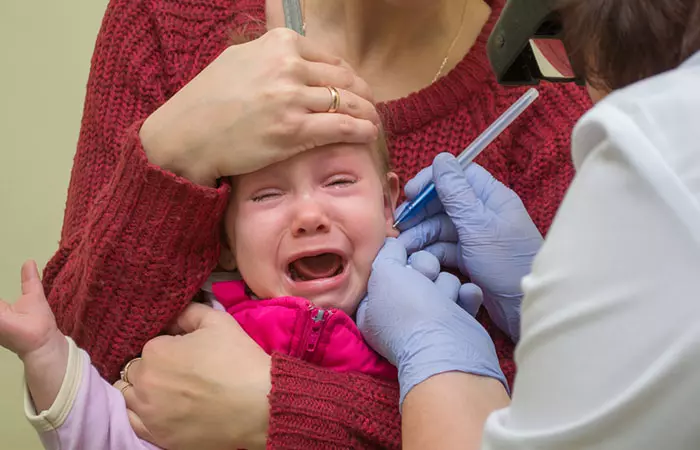
You can get the baby’s ears pierced at the hospital within a few days of the delivery. You can check with your pediatrician whether they offer medical piercing to ensure that it is done in sterile conditions, under the supervision of medical professionals. If your doctor does not have a provision for ear piercing, ask for a recommendation.
Healthcare professionals understand the complications that may arise due to improper baby ear piercings, and hence ensure the use of sterilized needles and follow strict hygienic methods. They also use earrings made of hypoallergenic stainless steel. This makes certain that experienced hands that handle surgical processes will handle baby piercings, so you can rest easy.
On the other hand, jewelry stores or kiosks offer ear piercing services using piercing guns. However, this is not a recommended place to pierce your baby’s ears as the guns cannot be appropriately sterilized. It is also possible that the workers may not be experienced enough to handle baby ear piercings.
Khushboo, a mom blogger, penned her opinion about baby ear piercing and her personal experience. She got her child’s ear pierced when she was 5 months old by a pediatrician. She writes, “We made an appointment with a credited paediatrician, in a well reputed hospital and purchased medical studs from the same facility (i).” Single-use sterile tools were used for piercing, and the baby was all smiles in about 10 minutes.
Once you have zeroed in on the how and where of baby ear piercing, let us shift the focus to the healing process. Read below for understanding the approximate healing time to help ensure a smooth ear-piercing recovery period for your little one.
How Long Does A Baby’s Ear Piercing Take To Heal?
Baby ear piercings take at least six weeks to heal. But there may occur variations in the healing time based on several factors, such as age and immunity level. Additionally, proper aftercare can ensure quick healing, which is why we have listed two of the most important aftercare pointers to keep in mind:
- Do not change or remove the earring during the healing period.
- The earring should be a perfect fit. Excessive tightness of the earring can cause pressure on the ear lobe and affect the blood supply to the pierced area. This can interfere with the healing process and prolong the healing time.
Signs Of Healthy Healing
- Minimal redness and swelling that subsides within a few days
- Mild discomfort (not severe pain) that decreases over time
- Clear or light white discharge with no foul odor
- No warmth or heat around the piercing site
- Steady improvement in the appearance of the piercing
- No excessive crusting or bumps like keloids
- Reduced tenderness over a period of a few days
The healing time is directly dependent on the aftercare measures. The section below will help you create a proper care routine for your baby’s newly pierced ears for a comfortable healing process.
Baby Ear Piercing Aftercare
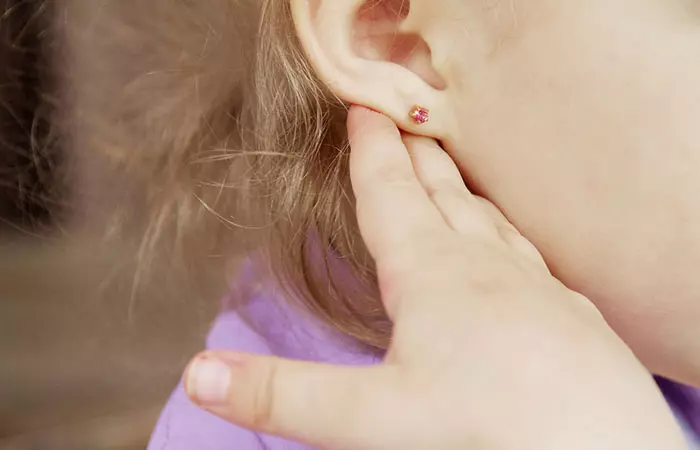
All types of ear piercings pose a threat of infection, and the chances are higher when they are done outside the hospital environment. Proper management and adherence to aftercare instructions will decide how well the piercings heal and their longevity.
Following the routine aftercare methods as listed below can keep the ear piercings healthy and comfortable for the little one:
Dos
- Be sure to wash your hands thoroughly before touching your baby’s piercing.
- Touch the piercing only to clean it! Avoid any other unnecessary contact.
- Wash hands with warm water and antibacterial soap or cleanser before cleaning the ear lobes.
- Use a topical antibiotic around the piercing area, front and back, twice daily.
- Keep the piercing area clean and dry after each bath.
Don’ts
- Touch the piercing unnecessarily
- Use harsh soaps or scrubs on the pierced area.
- Apply lotions directly to the piercing.
- Swim or soak in hot tubs until the piercing is fully healed.
- Pick or peel at any scabs that form.
- Change the jewelry too soon.
Your little one may look adorable in those studs, but the process is accompanied by the risk of infection. Understanding the symptoms and remedies can make it an easy and comfortable journey for you and your baby.
However, infections are also common and often unpredictable; what can you do in such cases? Read below for some words of caution when dealing with a baby’s ear piercing infection, as well as tips on how to clean the ear piercing properly.
How To Deal With A Baby’s Ear Piercing Infection
The common signs of ear piercing infection include pain, pus formation and discharge, bleeding, inflammation, fever or warmth, and redness of the piercing area. If any of these symptoms afflict your baby, you can follow the below steps to take care of the infection and facilitate the healing of the wound:
- Do not remove or tug at the earring.
- Clean the piercing site with a saline solution at least twice a day.
- Contact your pediatrician to get a prescription for an antibiotic ointment or cream; apply it carefully to the earlobe.
- Avoid using harsh chemicals, such as rubbing alcohol or hydrogen peroxide, on the sensitive baby skin.
- Get medical help if the condition does not improve within two days of home treatment.
If the doctor advises removing the earring and the hole closes, don’t worry—re-piercing ears at a later stage is not so complicated.
While proper aftercare can help prevent an infection, the choice of jewelry also plays a crucial role in preventing irritation and infection of the piercing site. Read on to learn more about the various jewelry materials available and how to choose the right one.
How To Select The Right Baby Ear Piercing Jewelry
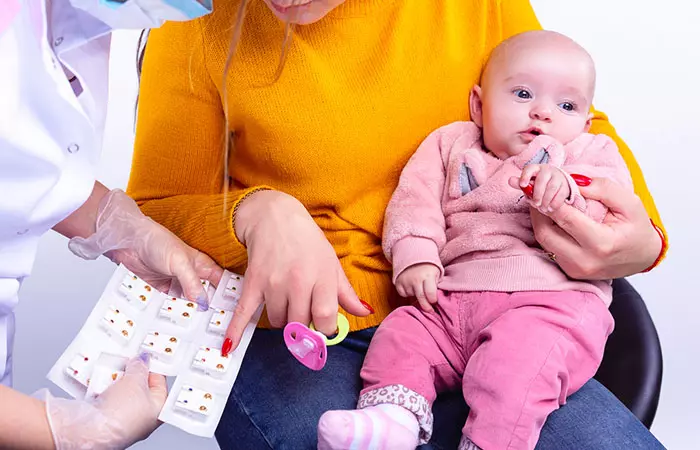
- Use jewelry made of hypoallergenic materials. Surgical steel and 14k gold are the most preferred options for baby ear jewelry. Additionally, you can also consider platinum and titanium.
- Avoid other metals and mixed-metal options as they may cause allergic reactions.
- Small earrings with rounded edges and a flat front portion are the best suited for your baby’s ears.
- The fastener at the back should cover a significant portion of the back of the earrings to prevent it from embedding into the hole.
- Do not use danglers or rings as the child may tug at them, or they may get caught on something, causing tissue tears.
- Use secure screw-back earrings to prevent them from falling out and causing a choking hazard.
Before you decide to get an ear piercing for your little one, it is important to be aware of the potential risks associated with the process. Scroll down to understand the safety concerns and challenges involved in the process and how you can avoid such situations.
What Are The Risks Of Baby Ear Piercing?
Piercing involves puncturing the body, and it comes with associated risks. The possible dangers with baby ear piercings include:
- Bleeding: There can be excessive bleeding at the piercing site.
- Infection: A newborn’s immune system is very fragile, so it is recommended to refrain from piercing a newborn. The baby will have to be hospitalized in case of any infection. Infection at the site of piercing will require antibiotic administration, which may pose a risk for developing newborns. Unclean piercing process may pose a risk of hepatitis B or C (2).
- Allergic Reaction To The Tools Or Earrings: Low-quality steel or nickel are the common culprits that can lead to contact dermatitis and chronic inflammation, increasing the risk of infection.
- Swelling: The back of the earring may get embedded into the piercing hole. A tight earring can swell the ear lobe and worsen the condition, leading to pain, tissue damage, and infection.
- Keloids: Scarring of the skin can develop into a keloid, where some people are more prone to developing keloid scars in response to a wound.
- Tears: Accidental pulling at the ear lobe can lead to trauma of the delicate ear lobe and tear the skin.
- Asphyxiation: The risk of asphyxiation is one of the most serious concerns. The earring may dislodge from the baby’s ear and fall into the child’s mouth, posing a choking hazard.
Psychological Aspects and Concerns
While the physical risks of ear piercings are significant, parents may also have concerns about the psychological implications they have on their infant.
A common concern is whether parents should make the decision to pierce their baby’s ears or wait until the child is old enough to choose for themselves. Some worry that piercing at a young age may affect the child’s sense of control over their own body and appearance later on in life.
To address these concerns, it is important to:
- Consider the cultural context. If ear piercing is a family tradition or cultural norm, it can be a way to connect the baby with their heritage.
- Prioritize the health of the baby.
- Reassure yourself that ear piercing is a common and generally safe procedure.
- By discussing the decision with family and considering future implications, parents can ensure they are making a thoughtful choice that respects both tradition and their child’s autonomy.
You are bound to think several times before you decide to do something that will cause pain to the little one. Read on to understand the pain a piercing can cause for a baby.
Does An Ear Piercing Hurt The Baby?
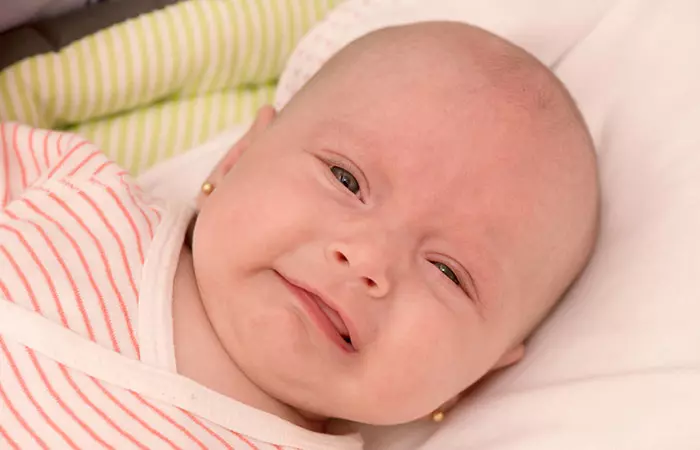
Doctors do not use anesthesia injections for ear piercings due to the mild and bearable pain caused by the process. In fact, it is comparatively less painful than a vaccine injection. Keep the baby distracted or occupied and hold her tight to prevent movement, as even the slightest wiggle can make it challenging.
It is a common occurrence that the pain of the first piercing makes the baby uncomfortable and teary, making it taxing to console them to get the next shot. Check if you can get both ears pierced simultaneously to prevent this issue. The pain may persist for 1-2 days and can be alleviated with mild pain medication. Check below for ways to manage the pain for your baby.
How To Minimize Pain From Infant Ear Piercing
If you are concerned about causing pain to your baby, or do not want the sudden pain to disturb the piercing healing process, pain minimizers can be administered. The application of topical anesthesia or the use of an ice pack can help in this regard.
The pain at the piercing site may be uncomfortable for the baby for the first few days, so be gentle and consistent with the aftercare process. Keep the baby distracted with toys and by playing with them. If you successfully keep the area clean and infection-free, the pain will go away in a concise period.
Baby ear piercings are usually considered safe, provided the precautionary steps and aftercare are strictly followed. Deciding when to get your baby’s ears pierced is a personal choice that requires careful consideration. Always consult your pediatrician and be aware of the risks to prevent any infections. Medical professionals recommend getting a baby’s ears pierced done at a hospital to ensure hygienic conditions and proper medical care. Follow proper aftercare guidelines to speed up the healing process and for a smooth piercing experience for your little one.
Frequently Asked Questions
Can my baby go swimming after getting their ears pierced?
Not really. Newly pierced ears are open wounds, and water sources like swimming pools and hot tubs harbor bacteria that can increase the risk of infection. Typical baby ear piercings take around 2 to 3 weeks to heal. Consult your pediatrician regarding the proper timeline to avoid contracting an infection.
Is it bad to put numbing cream on before a piercing?
It can be. Numbing creams can help with pain relief as they temporarily desensitize the nerve endings in the top layer of the skin. However, since they work by constricting the blood vessels, when the cream wears off, the piercing may be crooked. And crooked piercings do not heal well. They are also not actually effective as they can numb the pain only on the surface, and piercings go beyond the skin layer. They can also irritate the piercing and are not recommended for puncture wounds.
Can a baby sleep on the side after getting an ear piercing?
Sleeping on the side can exert pressure on the ear lobe and cause the earring to get embedded into the hole. Try to put the baby on the back till the wound is healed.
Should I give my baby Tylenol before ear piercing?
Before giving any medicine to your baby, you should discuss it with your pediatrician. If you are getting the piercing done in a hospital, the doctor may administer acetaminophen/Tylenol in the appropriate dosage to combat pain and manage potential discomfort.
Do babies get fussy after getting an ear piercing?
Yes, babies may get fussy and irritated after an ear piercing due to the pain and discomfort. Try to distract them from the pain with toys and, if prescribed, proper dosages of pain medication.
Getting your baby’s ear pierced by a doctor is the safe and professional route to ensure it is done under sterile conditions. Watch this video to understand how children’s ears are pierced in a doctor’s office, following proper sterilization techniques. .
Personal Experience: Source
StyleCraze's articles are interwoven with authentic personal narratives that provide depth and resonance to our content. Below are the sources of the personal accounts referenced in this article.
(i) Having My Toddler’s Ears Pierced
https://mumzynotebook.wordpress.com/2017/05/13/having-my-toddlers-ears-pierced/
References
Articles on StyleCraze are backed by verified information from peer-reviewed and academic research papers, reputed organizations, research institutions, and medical associations to ensure accuracy and relevance. Read our editorial policy to learn more.
- Relationship between age of ear piercing and keloid formation
https://publications.aap.org/pediatrics/article-abstract/115/5/1312/67513/Relationship-Between-Age-of-Ear-Piercing-and - Transmission of hepatitis B and C virus infection through body piercing
https://www.ncbi.nlm.nih.gov/pmc/articles/PMC5058954/
Read full bio of Ikramul Haque Shazib
Read full bio of Reshma Latif
Read full bio of Madhumati Chowdhury
Read full bio of Joyce Joyson





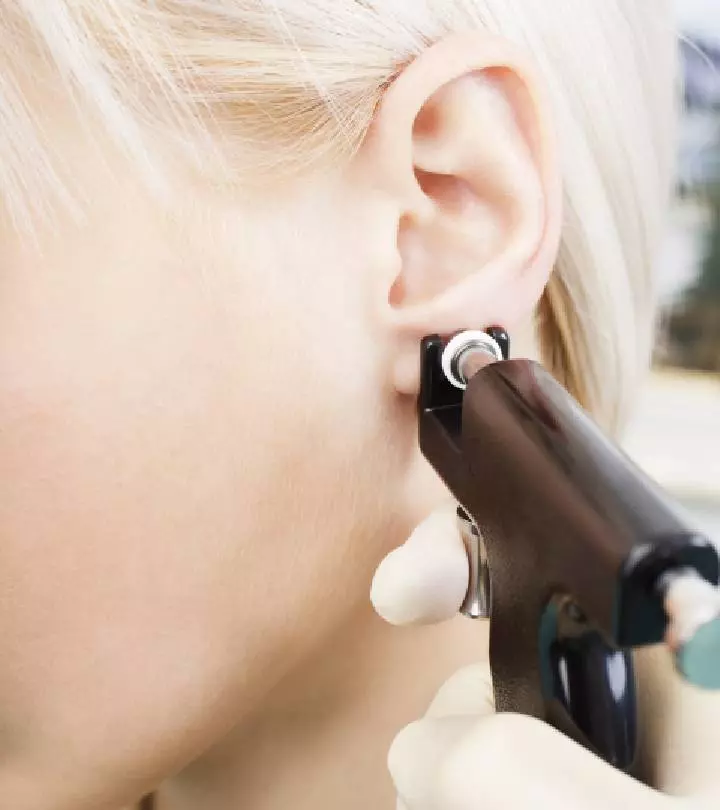
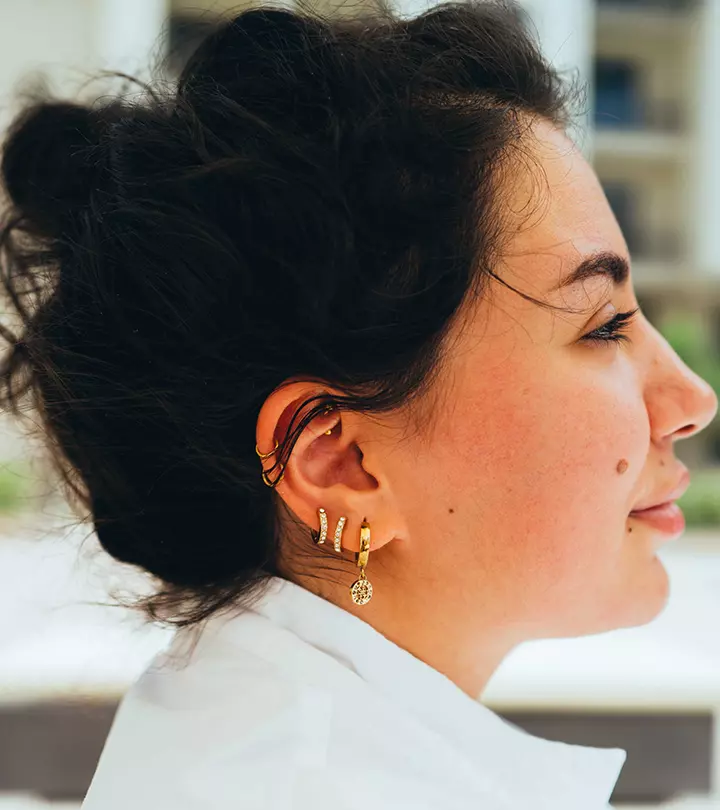
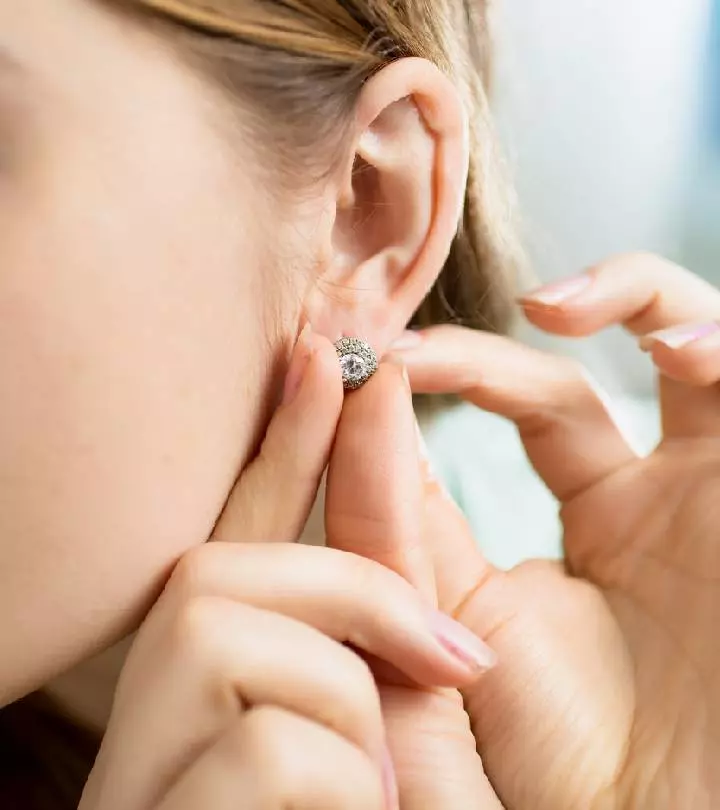
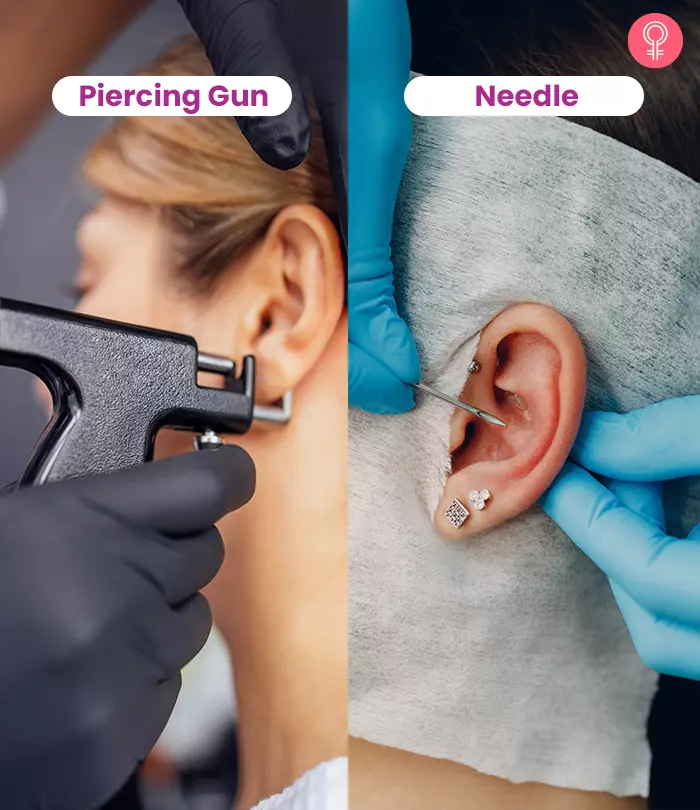
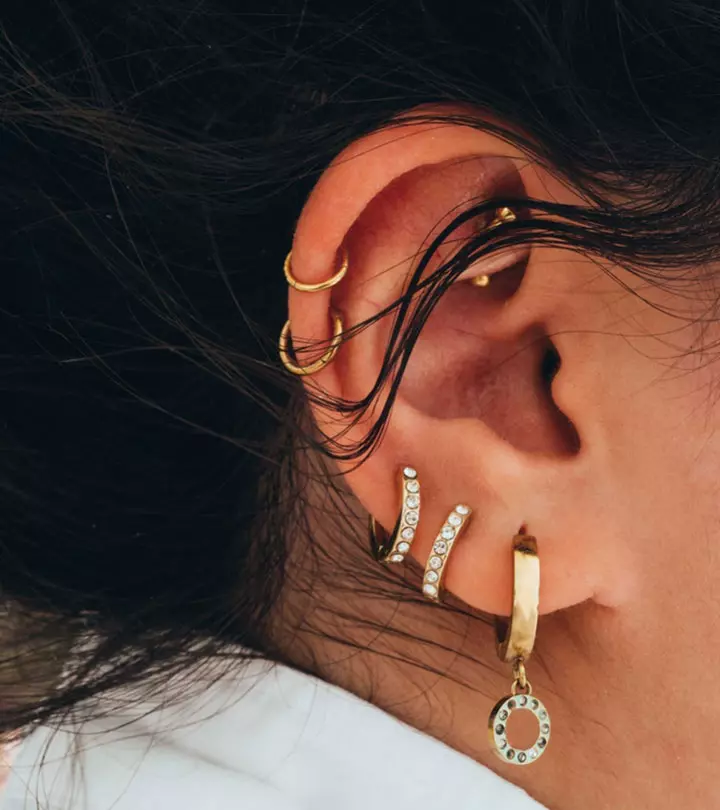
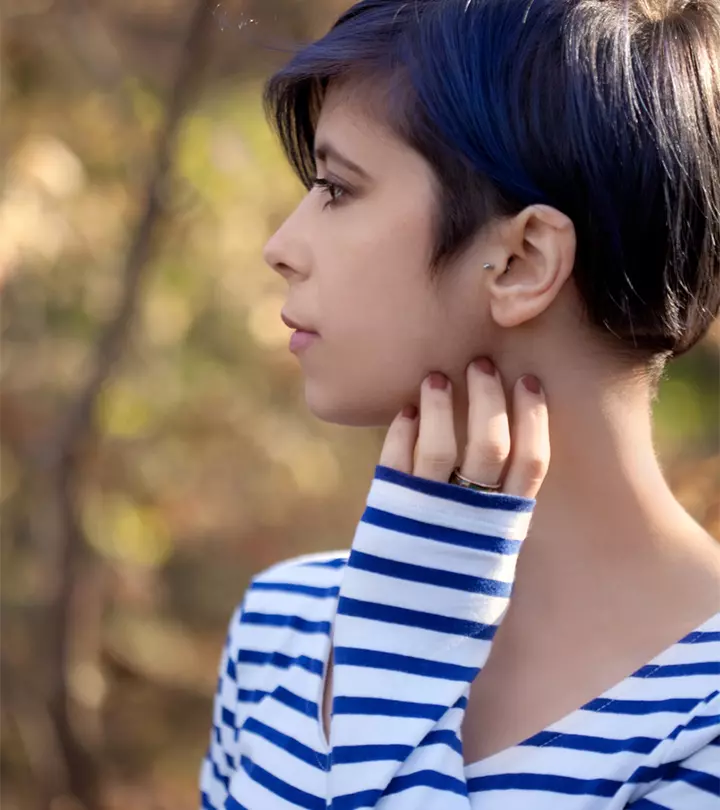
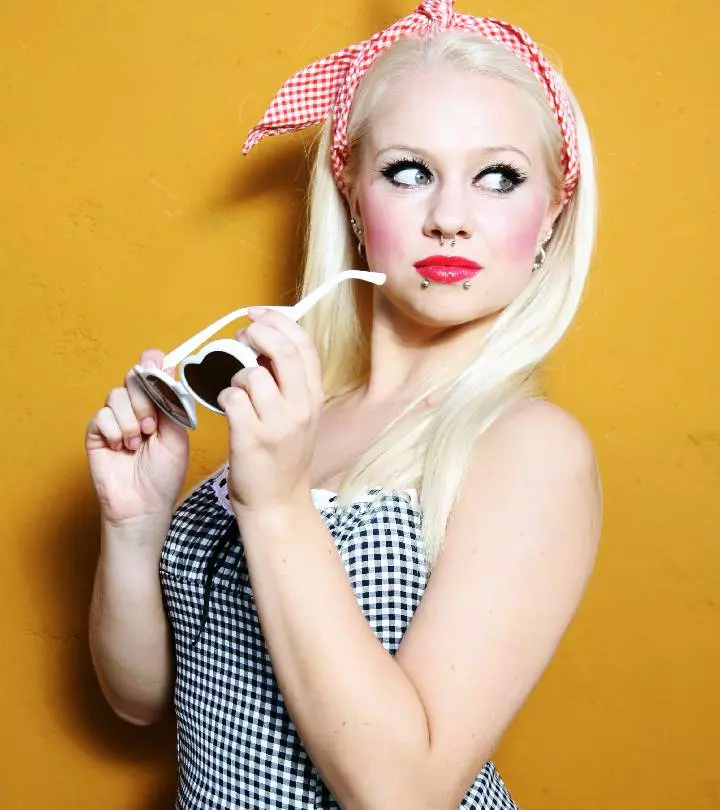
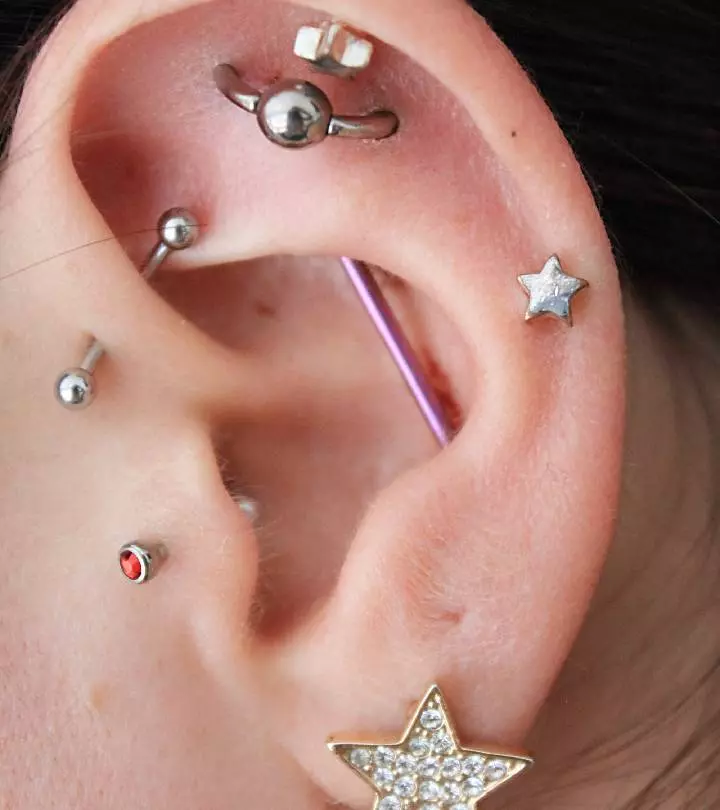
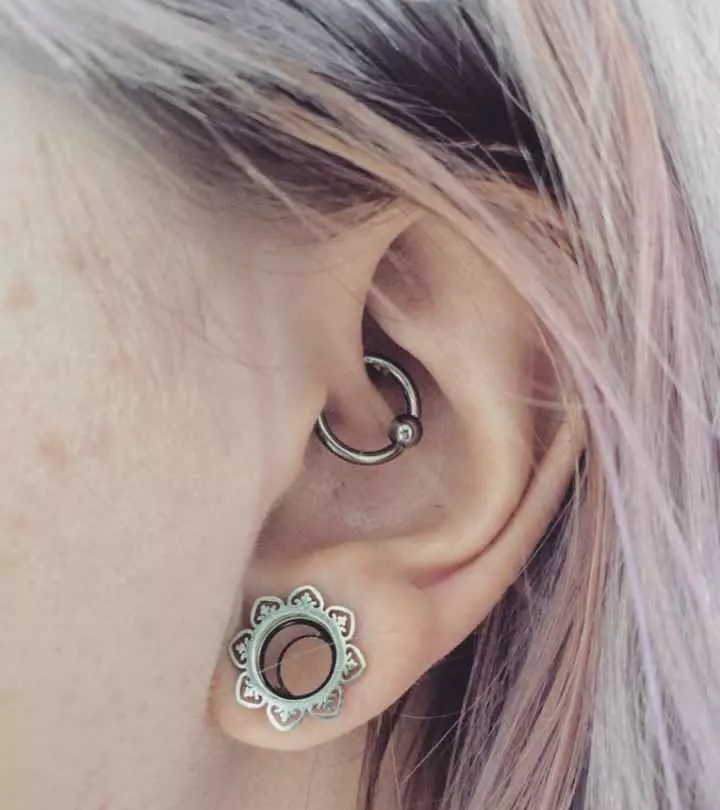
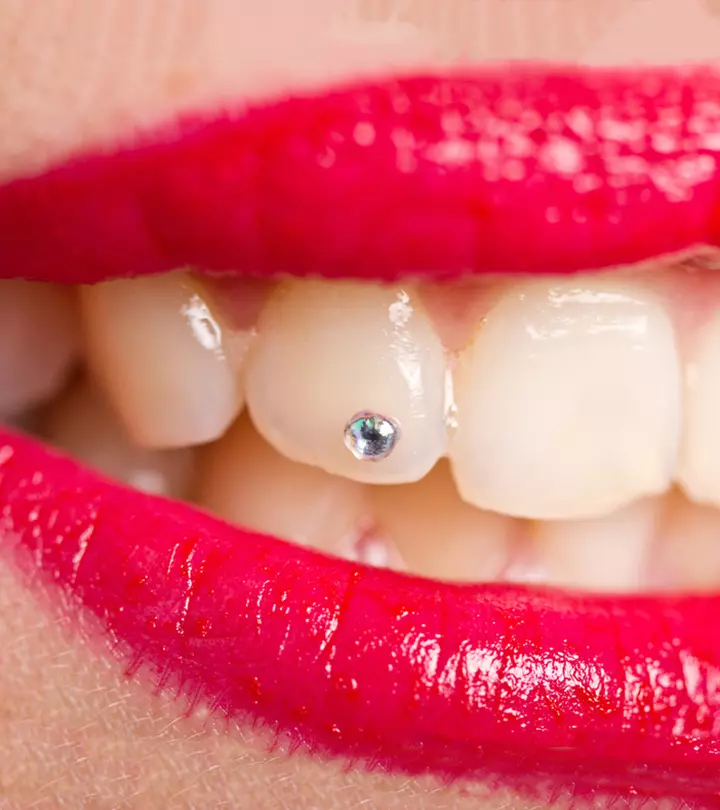
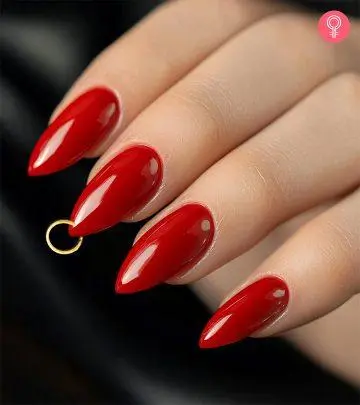
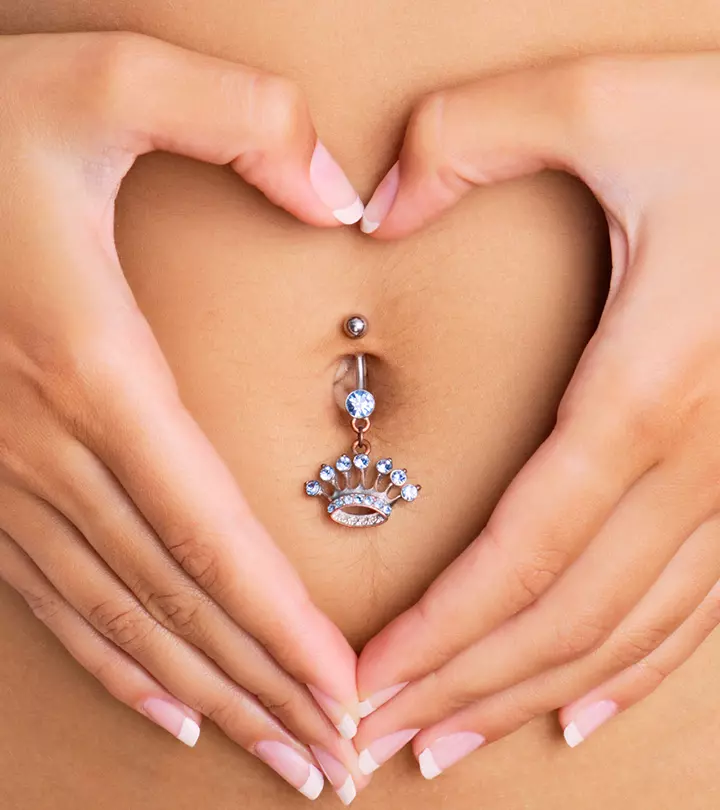
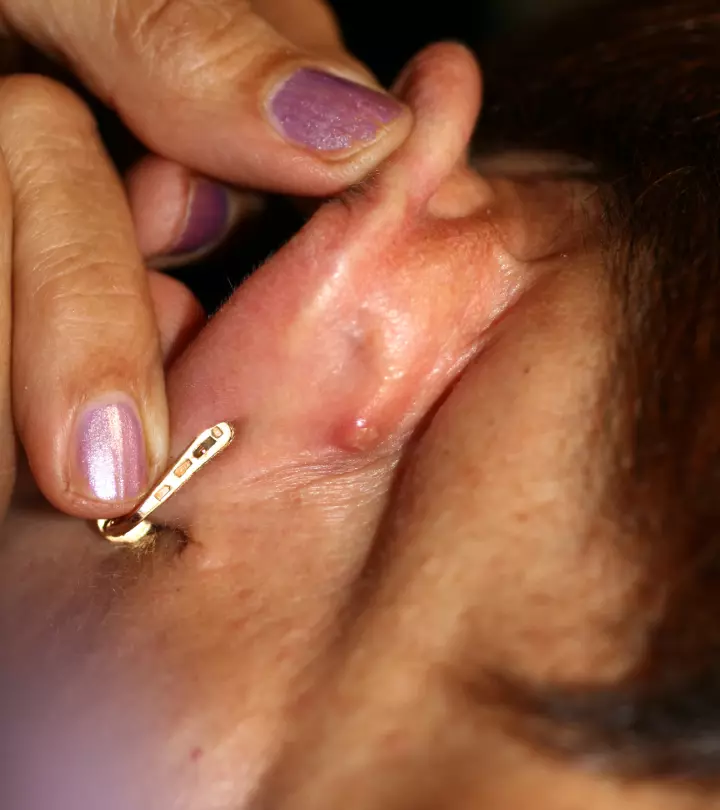
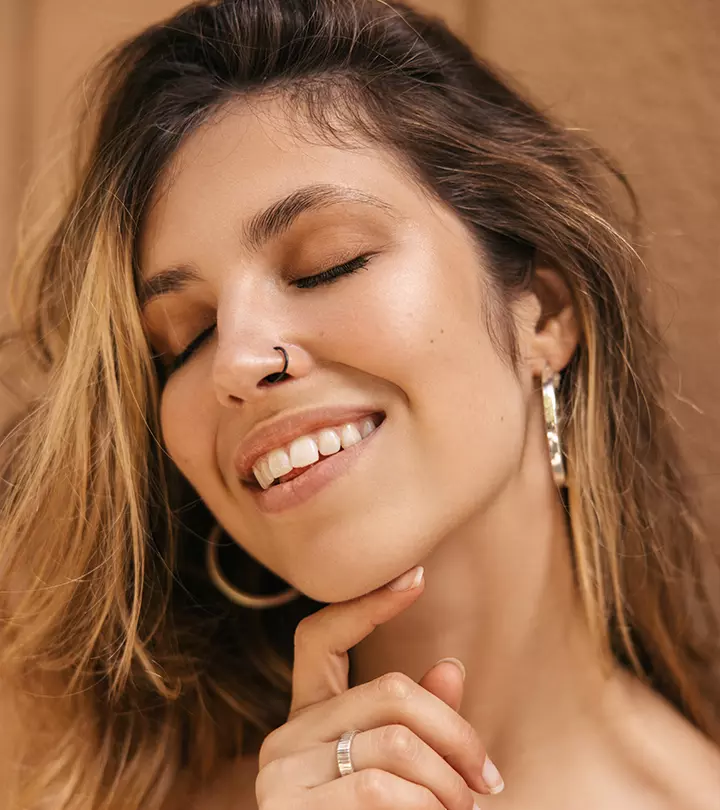

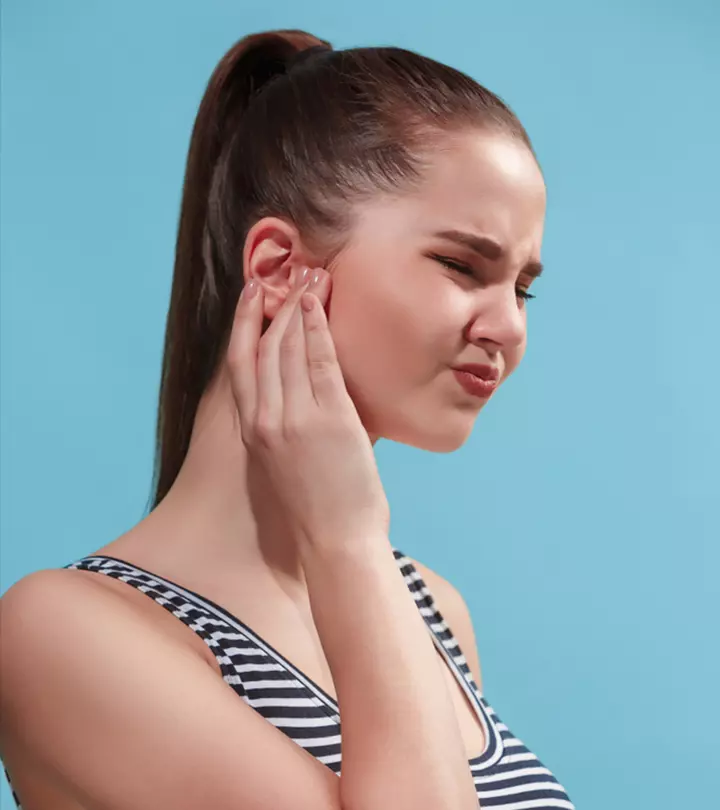

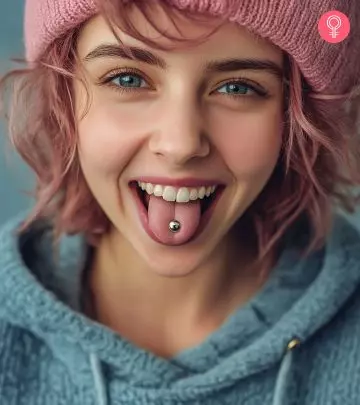



Community Experiences
Join the conversation and become a part of our empowering community! Share your stories, experiences, and insights to connect with other beauty, lifestyle, and health enthusiasts.